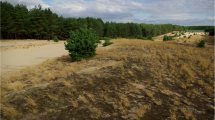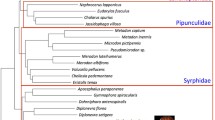Abstract
Wingless “ergatoid” males of the ant genus Cardiocondyla have repeatedly been described as females of novel genera of workerless social parasites (Emeryia and Xenometra), which after recognition of their real nature were synonymized with Cardiocondyla. Examination of ants newly collected from Comoé National Park in Côte d’Ivoire, West Africa revealed that winged Cardiocondyla males have sparked a similar misidentification: the “winged female sexuals” of the supposed inquiline Cardiocondyla zoserka Bolton 1982, known only from the type material from Nigeria, are in fact the winged males of their presumed host, a species of the Cardiocondyla shuckardi group (sensu Seifert 2002). The types of C. zoserka are immediately recognizable by their strangely modified antennal funiculi with cup-shaped apical segments, which do not resemble any other known ant antenna. More than twenty winged individuals from two Cardiocondyla colonies from the flood plain of Comoé River exhibited the same strange modifications of their antennae and were otherwise also similar to the C. zoserka type specimens. However, these winged ants turned out to be winged males rather than winged female sexuals. The inspection of the holotype and one paratype of C. zoserka verified that they also were males: like the winged males from Comoé N.P., they have concealed male genitals and ocelli, which are considerably larger than those of the female sexuals of Cardiocondyla. All female sexuals and workers found in the colonies with the bizarre winged males from Comoé N.P. had antennae with a three-segmented club as is typical for this genus. Sequences of the mitochondrial cytochrome c oxidase subunits I (CO I) and II (CO II) of a winged male and two nestmate workers showed that they are close to C. venustula and C. shuckardi but differ from them in about 10% of the base pairs. Other samples of Cardiocondyla collected in Comoé N.P. belong to C. venustula and related species. Their males were always ergatoid or “intermorphic” (i.e., ergatoid with rudimentary wings), as previously found in other populations of C. venustula, and never winged with modified antennae.




Similar content being viewed by others
References
Alpert GD (2007) A review of the ant genus Metapone Forel from Madagascar. In: Snelling RR, Fisher BL and Ward PS (eds) Advances in ant systematics (Hymenoptera: Formicidae): homage to E.O. Wilson–50 years of contributions, vol 80. Memoirs American Entomological Institute, Ann Arbor, pp 8–18
Baroni Urbani C (1973) Die Gattung Xenometra, ein objektives Synonym. Mitt Schweizer Entomol Ges 46:199–201
Bernard F (1957) Xenometra Emery, genre de fourmis parasite nouveau pour l’Ancien Monde. Bull Soc Ent Fr 62:100–103
Bolton B (1982) Afrotropical species of the myrmicine ant genera Cardiocondyla, Leptothorax, Melissotarsus, Messor and Cataulacus (Formicidae). Bull Brit Mus (Nat Hist) Entomol 45:307–370
Boomsma JJ, Baer BC, Heinze J (2005) The evolution of male traits in social insects. Annu Rev Entomol 50:395–420. https://doi.org/10.1146/annurev.ento.50.071803.130416
Boudinot BE, Wachkoo AA, Bharti H (2016) The first ergatoid male of Platythyrea (Hymenoptera: Formicidae: Ponerinae), with contribution to colony labor suggested by observation and comparative morphology. Myrmecol News 22:59–64
Emery C (1909) Beiträge zur Monographie der Formiciden des paläarktischen Faunengebietes. (Hym.).Teil VI. Deutsche Ent Zeitschr 1909:19–37
Emery C (1917) Questions de nomenclature et synonymies relatives à quelques genres et espèces de Formicides (Hym.). Bull Soc Entomol Fr 1917:94–97
Forel A (1890) Aenictus—Typhlatta découverte de M. Wroughton. Nouveaux genres de Formicides. Ann Soc Entomol Belgique 34:102–114
Forel A (1892a) Die Ameisenfauna Bulgariens. Verh Zool Bot Ges Wien 42:305–318
Forel A (1892b) Le mâle des Cardiocondyla et la reproduction consanguine perpétués. Ann Soc Ent Belg 36:458–462
Frohschammer S, Heinze J (2009) Male fighting and “territoriality” within colonies of the ant Cardiocondyla venustula. Naturwissenschaften 96:159–163. https://doi.org/10.1007/s00114-008-0460-2
Hall TA (1999) BioEdit: a user-friendly biological sequence alignment editor and analysis program for Windows 95/96/NT. Nucl Acids Symp Ser 41:95–98
Heinze J (2017) Life-history evolution in ants: the case of Cardiocondyla. Proc R Soc B 284:20161406. https://doi.org/10.1098/rspb.2016.1406
Heinze J, Hölldobler B (1993) Fighting for a harem of queens: physiology of reproduction in Cardiocondyla male ants. Proc Natl Acad Sci USA 90:8412–8414. https://doi.org/10.1073/pnas.90.18.8412
Heinze J, Tsuji K (1995) Ant reproductive strategies. Res Popul Ecol 37:135–149. https://doi.org/10.1007/BF02515814
Heinze J, Aumeier V, Bodenstein B, Crewe RW, Schrempf A (2013) Wingless and intermorphic males in the ant Cardiocondyla venustula. Insectes Soc 60:43–48. https://doi.org/10.1007/s00040-012-0263-5
Heinze J, Schrempf A, Wanke T, Rakotondrazafy H, Rakotondranaivo T, Fisher B (2014) Polygyny, inbreeding, and wingless males in the Malagasy ant Cardiocondyla shuckardi Forel (Hymenoptera, Formicidae). Sociobiology 61:300–306. https://doi.org/10.13102/sociobiology.v61i3.300-306
Isidoro N, Bin F, Romani R, Pujade-Villar J, Ros-Farré P (1999) Diversity and function of male antennal glands in Cynipoidea (Hymenoptera). Zool Scr 28:165–174. https://doi.org/10.1046/j.1463-6409.1999.00013.x
Jacobs S, Heinze J (2017) Between fighting and tolerance: reproductive biology of wingless males in the ant Cardiocondyla venustula. Insect Sci 24:818–828. https://doi.org/10.1111/1744-7917.12359
Jacobs S, Heinze J (2019) Population and colony structure of an ant with territorial males Cardiocondyla venustula. BMC Evol Biol 19:115. https://doi.org/10.1186/s12862-019-1448-6
Kinomura K, Yamauchi K (1987) Fighting and mating behaviors of dimorphic males in the ant Cardiocondyla wroughtoni. J Ethol 5:75–81. https://doi.org/10.1007/BF02347897
Kugler J (1983) The males of Cardiocondyla Emery (Hymenoptera: Formicidae) with the description of the winged male of Cardiocondyla wroughtoni (Forel). Isr J Entomol 17:1–21
Kumar S, Stecher G, Li M, Knyaz C, Tamura K (2018) MEGA X: molecular evolutionary genetics analysis across computing platforms. Mol Biol Evol 35:1547–1549. https://doi.org/10.1093/molbev/msy096
Loiselle R, Francoeur A (1988) Régression du dimorphisme sexuel dans le genre Formicoxenus et polymorphisme comparé des sexes dans la famille des Formicidae (Hymenoptera). Naturaliste Can (Rev ècol syst) 115:367–378
Marikovsky PI, Yakushkin VT (1974) The ant Cardiocondyla ulianini Em., 1889 and the systematic position of the “parasitic ant Xenometra”. Izv Akad Nauk Kaz SSR Ser Biol 3:57–62
Menozzi C (1918) Primo contributo alla conoscenza della fauna mirmecologica del Modenese. Atti Soc Nat Mat Modena 4:81–88
Mercier J-L, Lenoir J-C, Eberhardt A, Frohschammer S, Williams C, Heinze J (2007) Hammering, mauling, and kissing: stereotyped courtship behavior in Cardiocondyla ants. Insectes Soc 54:403–411. https://doi.org/10.1007/s00040-007-0960-7
Oettler J, Suefuji M, Heinze J (2010) The evolution of alternative reproductive tactics in male Cardiocondyla ants. Evolution 64:3310–3317. https://doi.org/10.1111/j.1558-5646.2010.01090.x
Renthal R, Velasquez D, Olmos D, Vinson SB (2008) Occurrence of antennal glands in ants. Microsc Res Techniq 71:787–791. https://doi.org/10.1002/jemt.20620
Romani R, Isidoro N, Riolo P, Bin F (2003) Antennal glands in male bees: structures for sexual communication by pheromones? Apidologie 34:603–610. https://doi.org/10.1051/apido:2003053
Romani R, Rosi MC, Isidoro N, Bin F (2008) The role of the antennae during courtship behaviour in the parasitic wasp Trichopria drosophilae. J Exp Biol 211:2486–2491. https://doi.org/10.1242/jeb.013177
Sambrook J, Russell D (2001) Molecular cloning: a laboratory manual. Cold Spring Harbor Laboratory Press, New York
Santschi F (1907) Fourmis de Tunisie capturées en 1906. Rev Suisse Zool 15:305–334
Seifert B (2002) The ant genus Cardiocondyla (Insecta: Hymenoptera: Formicidae)—a taxonomic revision of the C. elegans, C. bulgarica, C. batesii, C. nuda, C. shuckardi, C. stambuloffii, C. wroughtonii, C. emeryi, and C. minutior species groups. Ann Nat Mus Wien 104B: 203–338. https://www.jstor.org/stable/41767253. Accessed 1 Nov 2019
Simon C, Frati F, Beckenbach A, Crespi B, Liu H, Flook P (1984) Evolution, weighting, and phylogenetic utility of mitochondrial gene sequences and a compilation of conserved polymerase chain reaction primers. Ann Entomol Soc Am 87:651–701. https://doi.org/10.1093/aesa/87.6.651
Stuart RJ, Francoeur A, Loiselle R (1987) Lethal fighting among dimorphic males of the ant, Cardiocondyla wroughtonii. Naturwissenschaften 74:548–549. https://doi.org/10.1007/BF00367076
Tajima F, Nei M (1984) Estimation of evolutionary distance between nucleotide sequences. Mol Biol Evol 1:269–285. https://doi.org/10.1093/oxfordjournals.molbev.a040317
Thompson JD, Higgins DG, Gibson TJ (1994) CLUSTAL W: improving the sensitivity of progressive multiple sequence alignment through sequence weighting, position-specific gap penalties and weight matrix choice. Nucl Acids Res 22:4673–4680. https://doi.org/10.1093/nar/22.22.4673
Yamauchi K, Asano Y, Lautenschläger B, Trindl A, Heinze J (2005) A new type of male dimorphism with ergatoid and short-winged males in Cardiocondyla cf. kagutsuchi. Insectes Soc 52:274–281. https://doi.org/10.1007/s00040-005-0803-3
Acknowledgements
Research in Comoé Park was permitted by the director of the Office Ivorien des Parcs et Réserves (permit no. 221), the exportation of ants by a permit from the Ministère de l’ Enseignement Supèrieur et de la Recherche Scientifique. I thank Dr. Koné N’golo Abdoulaye, Dr. Erik Frank, and the staff of the Comoé Research Station for their help with obtaining permits and technical support. Claudia Gstöttl and Tina Wanke helped locating and excavating the colonies of Cardiocondyla. Tina Wanke and Birgit Lautenschläger assisted with Keyence and SEM photography and Andi Trindl and Nana Gratiashvili with DNA isolation and amplification. I thank Stefan Cover and Bernhard Seifert for their opinions about the type material of C. zoserka and Suzanne Ryder for providing the paratype from BMNH. The research was supported by Deutsche Forschungsgemeinschaft (He1623/42).
Author information
Authors and Affiliations
Corresponding author
Electronic supplementary material
Below is the link to the electronic supplementary material.
40_2019_737_MOESM1_ESM.pdf
Supplementary material 1 Figure S1 Bootstrap consensus tree of 814 bp fragments of the mitochondrial CO I gene from various samples of Cardiocondyla ants, inferred using the neighbor-joining method. Taxa representing species of the C. shuckardi group are shown in red (C. shuckardi from Madagascar) or black (C. venustula), the samples from Comoé National Park resembling C. zoserka are shown in green. Sequences of other species, e.g., C. emeryi, C. mauritanica, and C. nuda were added as outgroups in blue. The figures next to the branches indicate the percentage of replicate trees in which the associated taxa clustered together in the bootstrap test (500 replicates). Branches with a support of less than 60% were collapsed. For each sample, collecting site, and number, ISO country code (AU: Australia; CI: Côte d’Ivoire; EG: Egypt; ET: Ethiopia; FR: France; ID: Indonesia; KE: Kenya; MG: Madagascar; PR: Puerto Rico; PT: Portugal, US: USA; ZA: South Africa) and, if available, GenBank accession numbers are given. The tree only illustrates the identity of the sequences of a winged male, two nestmate workers and a worker from a second colony of the taxon from Côte d’Ivoire similar to C. zoserka and their difference from C. venustula/C. shuckardi. It is not meant to draw conclusions about the phylogeny of the various taxa. Samples with the collecting site “Comoé” are from the floodplain of Comoé River (8° 46′ 25′′ N, 3° 47′ 03′′ W). The collecting site “Comoé Gawi” is at 9° 00′ 19′′ N, 3° 47′ 53′′ W, “Comoé Iringo” at 8° 50′ 25′′ N, 3° 46′ 15′′ W, “Comoé Kongo River” at 8° 48′ 04′′ N, 3° 46′ 19′′ W, “Comoé Namba” at 8° 47′ 03′′ N, 3° 48′ 12′′ W, and “Comoé Res. Station” at 8° 46′ 14′′ N, 3° 47′ 23′′ W (PDF 934 kb).
Rights and permissions
About this article
Cite this article
Heinze, J. Emeryia, Xenometra, zoserka: it's a boy, again! The misleading morphology of Cardiocondyla male ants. Insect. Soc. 67, 139–146 (2020). https://doi.org/10.1007/s00040-019-00737-5
Received:
Revised:
Accepted:
Published:
Issue Date:
DOI: https://doi.org/10.1007/s00040-019-00737-5




